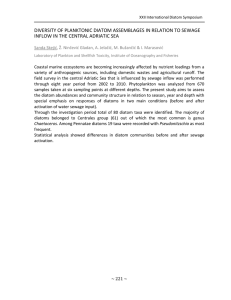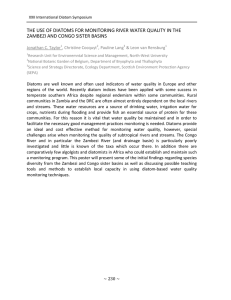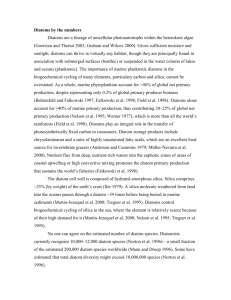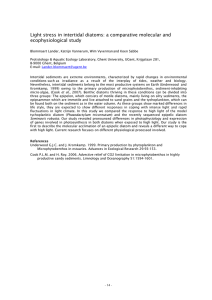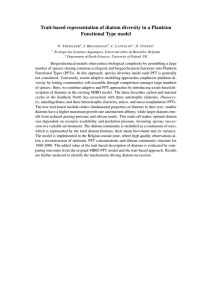Document 13013421
advertisement
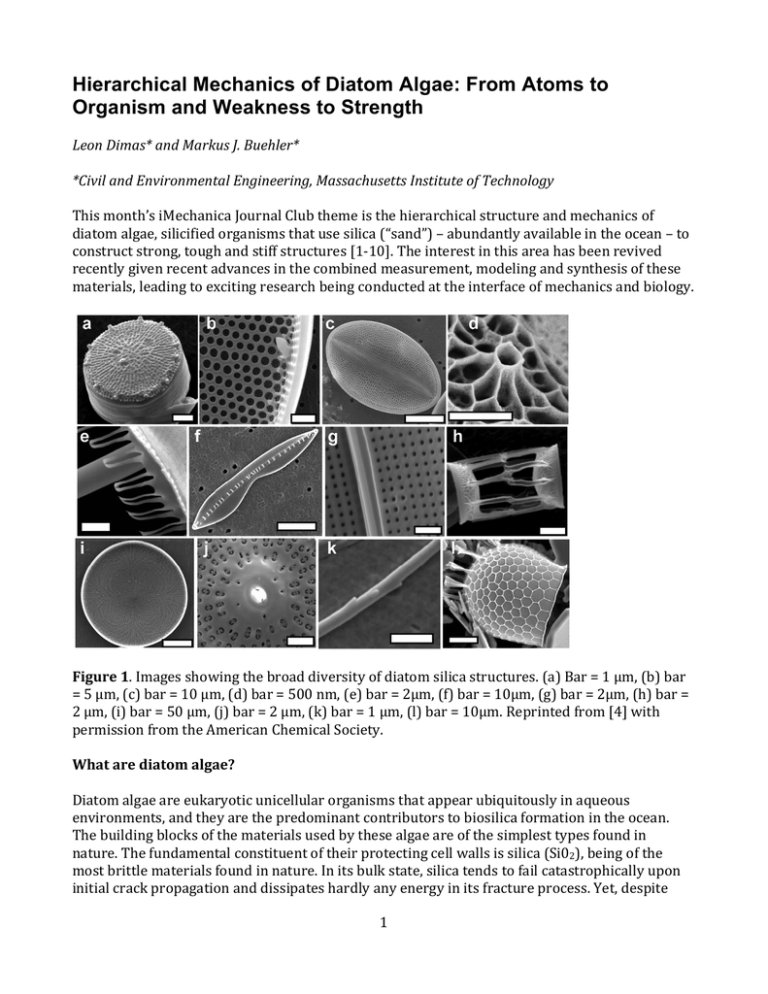
Hierarchical Mechanics of Diatom Algae: From Atoms to Organism and Weakness to Strength Leon Dimas* and Markus J. Buehler* *Civil and Environmental Engineering, Massachusetts Institute of Technology This month’s iMechanica Journal Club theme is the hierarchical structure and mechanics of diatom algae, silicified organisms that use silica (“sand”) – abundantly available in the ocean – to construct strong, tough and stiff structures [1-­‐10]. The interest in this area has been revived recently given recent advances in the combined measurement, modeling and synthesis of these materials, leading to exciting research being conducted at the interface of mechanics and biology. Figure 1. Images showing the broad diversity of diatom silica structures. (a) Bar = 1 µm, (b) bar = 5 µm, (c) bar = 10 µm, (d) bar = 500 nm, (e) bar = 2µm, (f) bar = 10µm, (g) bar = 2µm, (h) bar = 2 µm, (i) bar = 50 µm, (j) bar = 2 µm, (k) bar = 1 µm, (l) bar = 10µm. Reprinted from [4] with permission from the American Chemical Society. What are diatom algae? Diatom algae are eukaryotic unicellular organisms that appear ubiquitously in aqueous environments, and they are the predominant contributors to biosilica formation in the ocean. The building blocks of the materials used by these algae are of the simplest types found in nature. The fundamental constituent of their protecting cell walls is silica (Si02), being of the most brittle materials found in nature. In its bulk state, silica tends to fail catastrophically upon initial crack propagation and dissipates hardly any energy in its fracture process. Yet, despite 1 being made from this inferior building material the cell walls of alga exhibit mechanical properties characteristic of a highly advanced material, as shown by recent experimental and computational work [1-­‐9]. There exist almost 100,000 different species of diatoms that resemble a great diversity of geometrical shapes (Figure 1), and which all show a hierarchical structure from the nano-­‐ to the micrometer length scale (Figure 2). Figure 2. Schematic of a centric diatom. Figure adapted from [7] with permission from Springer. Challenges and opportunities One of the intriguing research questions is aimed at understanding the mechanisms by which silica-­‐based biomaterials attain enhanced mechanical properties despite their simple silica building blocks. A common trait among this phytoplankton is that they all have an exterior wall to protect their interior structures. These walls, commonly also known as frustules, can consist of one or several, layered, porous shells composed of nanostructured amorphous silica, with some organic components [3], typically sized at several tens of nanometers. Nonetheless, studies conducted on the mechanical response of frustules of diatom algae show these to exhibit impressive fracture properties far superior to their fundamental constituents [2, 3]. Even though the fundamental building blocks of the frustules of the different diatoms are silica in all cases, the specific mechanical response of the frustules is expected to vary from species to species. Several studies on the topic have shown significant variations in the geometrical composition of frustules from different diatom species [3, 6] (Figure 1). This is likely because different species are exposed to distinct environments and threats and may have variegated requirements for their protection. Investigations focused on frustule compositions in relation to environmental conditions and threats could perhaps lead to further insight in the specific mechanisms of how various geometries serve various mechanical functions. The walls can serve a broad variety of purposes all the way from inhibiting virus penetration, to the protection from the mandibles of and to resist digestion by predators. This makes diatoms particularly interesting from the point of view of designing armor and other protection materials. Experimental and theoretical mechanics 2 Recent advances in nanoscale imaging and indentation tools have served to deepen the insight into the architecture and mechanics of the frustule walls. Atomistic force microscopy, AFM, the October Journal Club topic, has been of particular importance here. In addition to serving as a powerful mechanical testing tool, use of AFM has increased the accessibility to measure the small-­‐scale geometries of these organisms. The mechanical properties of frustules have been shown to be highly site dependent, with some regions exhibiting stiffness’s reminiscent of bulk silica and other regions showing much softer responses, [6, 12]. Further, studies have revealed a fascinating and complex hierarchical architecture of the frustule walls with characteristic lengths ranging several scales [6, 7]. To display the complexities of diatom structures we briefly discuss the essentials of the frustule composition for the Conscinodiscus sp., a centric diatom. This taxon has a cell wall arrangement with three distinct porous silica layers; the cribellum, the cribrum and the foramen, listed in order from the exterior and inwards. In between the cribrum and the foramen layer a honeycomb like structure, named the areola, is observed. Honeycombs are a well-­‐known structure and provide high compression resistance with minimal weight and in the case of the areola likely increase overall strength of the frustule structure [7]. Each of the layers is associated with a distinct highly ordered meshwork arrangement of pores. Further, each layer is associated with a distinct pore size, varying almost two orders of magnitude from the smallest ones on the exterior cribellum, around 40 nm, to the largest ones on the inside foramen layer, with a diameter around 1 µm (Figure 2). In addition, the two outer frustule layers display a very interesting three-­‐dimensional topology, repetitions of dome resembling shapes along the surface. Domes are well known and commonly used in structural engineering purposes to form structures of minimal weight and material usage that are highly specialized to withstand compression loads. With mandibles of predators as an imminent threat the formation of these domes is likely a product of careful evolution. The domes lets the diatom frustule absorb these point loads predominantly in compression as opposed to in bending, which would be a far less material efficient way of absorbing the loading. The interplay of the different layers creates a structural hierarchy attaining superior mechanical properties [3, 6]. Further, as discussed above, the distribution of porosity within each layer results in softer and stiffer regions of the layer. This can allow plastic deformation to occur within the layer allowing significant deformation of the overall structure despite the brittleness of the building blocks. Hereby, the structure is able to absorb a significant amount of energy prior to fracture [9]. Porous arrangements can also cause significant crack deflections greatly increasing the fracture surface area created and therefore increase the necessary energy needed for fracture. A truly remarkable aspect is then that despite these porous arrangements the structure still manages to maintain a very high stiffness and fracture strength [9], values in the same range as widespread used engineering materials. In some diatom species the elastic stiffness can even reach several hundred GPas [12]! From a modeling point of view, continuum mechanics approaches [3] as well as molecular dynamics approaches [2] and combinations thereof [9, 10, 17, 18] can be appropriate to provide quantitative models of diatoms. In particular, the mesoscopic nature of the length scales associated with the geometries of the diatoms indicate that models must be able to reach throughout various length scales if they are to correctly capture the important phenomena related to key mechanical properties such as fracture. Outlook: Hierarchical structures in bioinspired materials 3 The hierarchical structures found in the frustules of diatoms vary from species to species, but they are a universal feature of all diatoms. With a limitation of high quality material resources as a design constraint, this natural system uses hierarchies and specific geometrical configurations as design parameters (Figure 2) [9-­‐11]. In the engineering realm, with cost effectiveness as an essential design criterion, this approach is fascinating and very appealing. Obviously, great advances could be made if we were capable of assembling inferior building blocks in such a beneficiary way as nature shows through the example of diatom algae. Can we produce materials with such sophisticated nanoscale geometries at a large scale, and can we reliably implement hierarchical materials in a similar way as achieved by diatoms? Would the associated assembling techniques be economically feasible? Our improved understanding holds the potential to design novel functional materials from simple building blocks, for applications ranging from optics to structural materials. References 1. Bao, Z.H., et al., Chemical reduction of three-­‐dimensional silica micro-­‐assemblies into microporous silicon replicas. Nature, 2007. 446(7132): p. 172-­‐175. 2. Garcia, A.P., Superductile, Wavy Silica Nanostructures Inspired by Diatom Algae. Advanced Engineering Materials, 2011. 13(10): p. 405-­‐414. 3. Hamm, C.E., et al., Architecture and material properties of diatom shells provide effective mechanical protection. Nature, 2003. 421(6925): p. 841-­‐843. 4. Hildebrand, M., Diatoms, Biomineralization Processes, and Genomics. Chemical Reviews, 2008. 108(11): p. 4855-­‐4874. 5. Losic, D., J.G. Mitchell, and N.H. Voelcker, Diatomaceous Lessons in Nanotechnology and Advanced Materials. Advanced Materials, 2009. 21(29): p. 2947-­‐2958. 6. Losic, D., et al., Atomic force microscopy (AFM) characterisation of the porous silica nanostructure of two centric diatoms. Journal of Porous Materials, 2007. 14(1): p. 61-­‐69. 7. Losic, D., et al., AFM nanoindentations of diatom biosilica surfaces. Langmuir, 2007. 23(9): p. 5014-­‐5021. 8. Medlin, L.K. and I. Kaczmarska, Evolution of the diatoms: V. Morphological and cytological support for the major clades and a taxonomic revision. Phycologia, 2004. 43(3): p. 245-­‐ 270. 9. Sen, D. and M.J. Buehler, Structural hierarchies define toughness and defect-­‐tolerance despite simple and mechanically inferior brittle building blocks. Scientific Reports, 2011. 1. 10. Garcia, A., N. Pugno, M.J. Buehler, Superductile, wavy silica nanostructures inspired by diatom algae, Advanced Biomaterials, 2011. 13: B405-­‐B414. 11. Knowles, T. and M.J. Buehler, Nanomechanics of functional and pathological amyloid materials. Nature Nanotechnology, 2011. 6(7), p. 469-­‐479. 12. Almqvist, N., et al., Micromechanical and structural properties of a pennate diatom investiagated by atomic force microscopy. Journal of Microscopy, 2001, 202(3): p. 518-­‐ 532 13. Nassif, N., Livage, J., From diatoms to silica based biohybrids. Chemical Society Reviews, 2011, 40(2): p. 849 – 859 14. Kroger, N., Sandhage, K.H., From Diatom Biomolecules to Biosinspired Syntheses of Silica-­‐ and Titania-­‐ Based Materials. MRS Bulletin, 2010, 35(2): p. 122-­‐126 4 15. 16. 17. 18. Sun, Q., Bioinspired synthesis of mesoporous silicas. Current Opinion in Solid State and Materials Science, 2004, 8(2): p. 111-­‐120 Xu, M., Biomimetic silicification of 3D polyamine-­‐rich scaffolds assembled by direct ink writing. Soft Matter, 2006, 2: p. 205-­‐209 Nuggehally, M.H., Adaptive model selection procedure for concurrent multiscale problems. International Journal for Multiscale Computational Engineering, 2007, 5(5): p. 369-­‐386 Datta, D.K., Composite grid atomistic continuum method: an adaptive approach to bridge continuum with atomistic analysis. International Journal for Multiscale Computational Engineering, 2004, 2(3) 5

